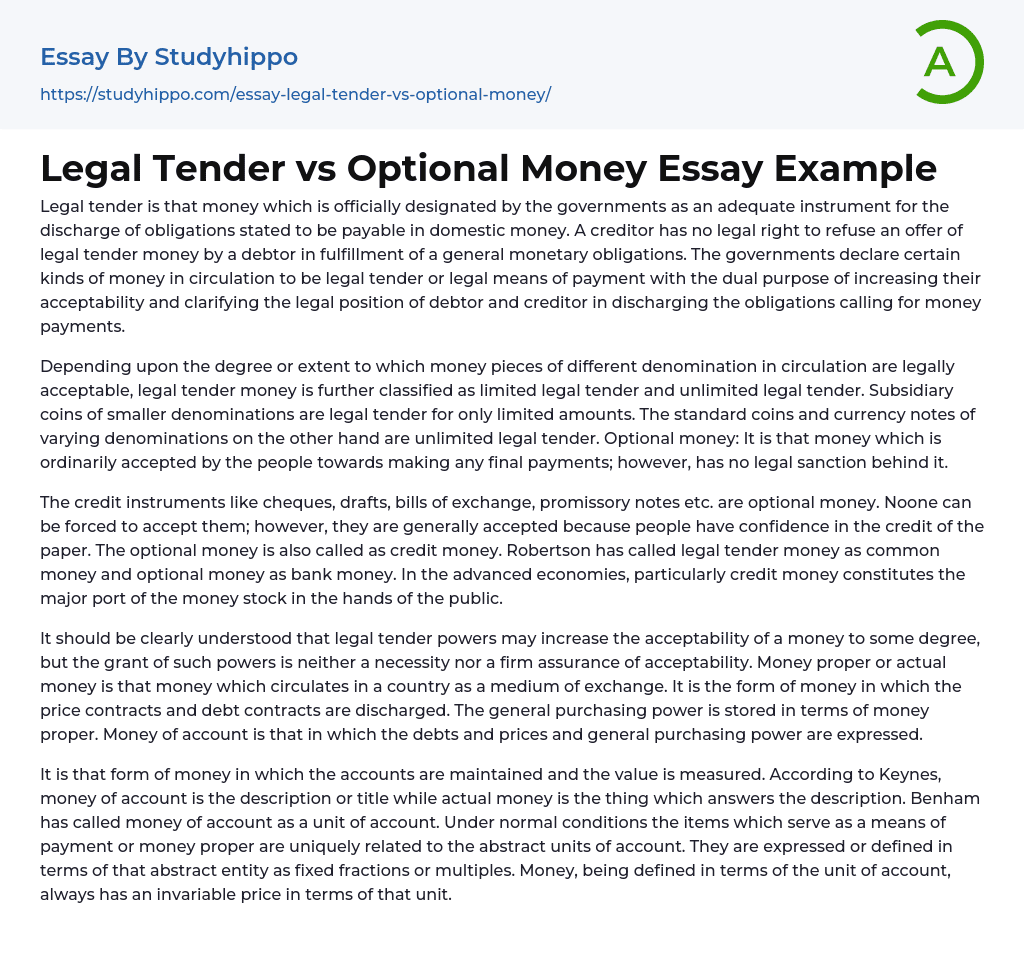Legal tender is that money which is officially designated by the governments as an adequate instrument for the discharge of obligations stated to be payable in domestic money. A creditor has no legal right to refuse an offer of legal tender money by a debtor in fulfillment of a general monetary obligations. The governments declare certain kinds of money in circulation to be legal tender or legal means of payment with the dual purpose of increasing their acceptability and clarifying the legal position of debtor and creditor in discharging the obligations calling for money payments.
Depending upon the degree or extent to which money pieces of different denomination in circulation are legally acceptable, legal tender money is further classified as limited legal tender and unlimited legal tender. Subsidiary coins of smaller denominations are le
...gal tender for only limited amounts. The standard coins and currency notes of varying denominations on the other hand are unlimited legal tender. Optional money: It is that money which is ordinarily accepted by the people towards making any final payments; however, has no legal sanction behind it.
The credit instruments like cheques, drafts, bills of exchange, promissory notes etc. are optional money. Noone can be forced to accept them; however, they are generally accepted because people have confidence in the credit of the paper. The optional money is also called as credit money. Robertson has called legal tender money as common money and optional money as bank money. In the advanced economies, particularly credit money constitutes the major port of the money stock in the hands of the public.
It should be clearly understood that legal
tender powers may increase the acceptability of a money to some degree, but the grant of such powers is neither a necessity nor a firm assurance of acceptability. Money proper or actual money is that money which circulates in a country as a medium of exchange. It is the form of money in which the price contracts and debt contracts are discharged. The general purchasing power is stored in terms of money proper. Money of account is that in which the debts and prices and general purchasing power are expressed.
It is that form of money in which the accounts are maintained and the value is measured. According to Keynes, money of account is the description or title while actual money is the thing which answers the description. Benham has called money of account as a unit of account. Under normal conditions the items which serve as a means of payment or money proper are uniquely related to the abstract units of account. They are expressed or defined in terms of that abstract entity as fixed fractions or multiples. Money, being defined in terms of the unit of account, always has an invariable price in terms of that unit.
- Bank essays
- Banking essays
- Corporate Finance essays
- Credit Card essays
- Currency essays
- Debt essays
- Donation essays
- Enron Scandal essays
- Equity essays
- Financial Accounting essays
- Financial Crisis essays
- Financial News essays
- Financial Ratios essays
- Financial Services essays
- Forecasting essays
- Foreign Exchange Market essays
- Free Market essays
- Gold essays
- Investment essays
- Legacy essays
- Loan essays
- Market Segmentation essays
- Money essays
- Personal finance essays
- Purchasing essays
- Retirement essays
- Shareholder essays
- Stock Market essays
- Supply And Demand essays
- Venture Capital essays
- American Dream essays
- Barriers To Entry essays
- Capitalism essays
- Central Bank essays
- Compensation essays
- Consumerism essays
- Economic Development essays
- Economic Growth essays
- Economic Inequality essays
- Economic System essays
- Economy essays
- Employment essays
- Export essays
- Finance essays
- Free Trade essays
- Gross Domestic Product essays
- Human Development essays
- Income Inequality essays
- Industry essays
- Inflation essays




